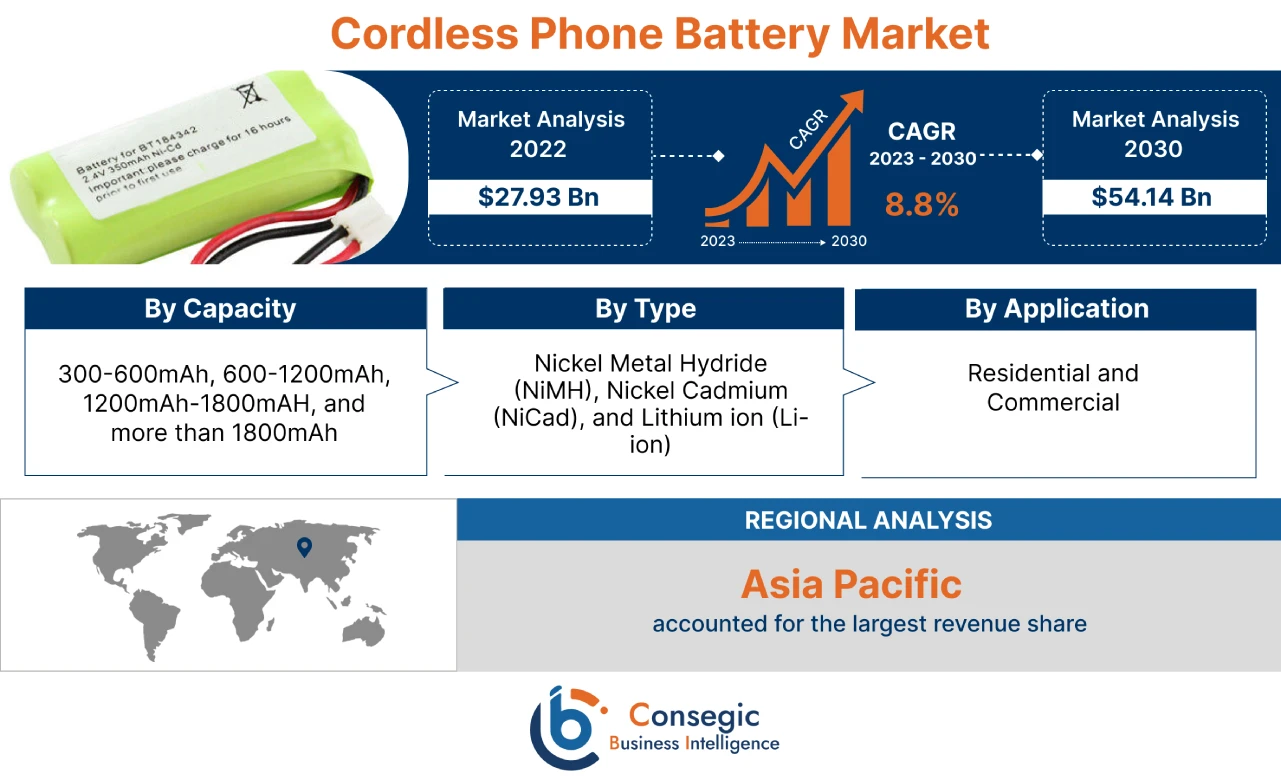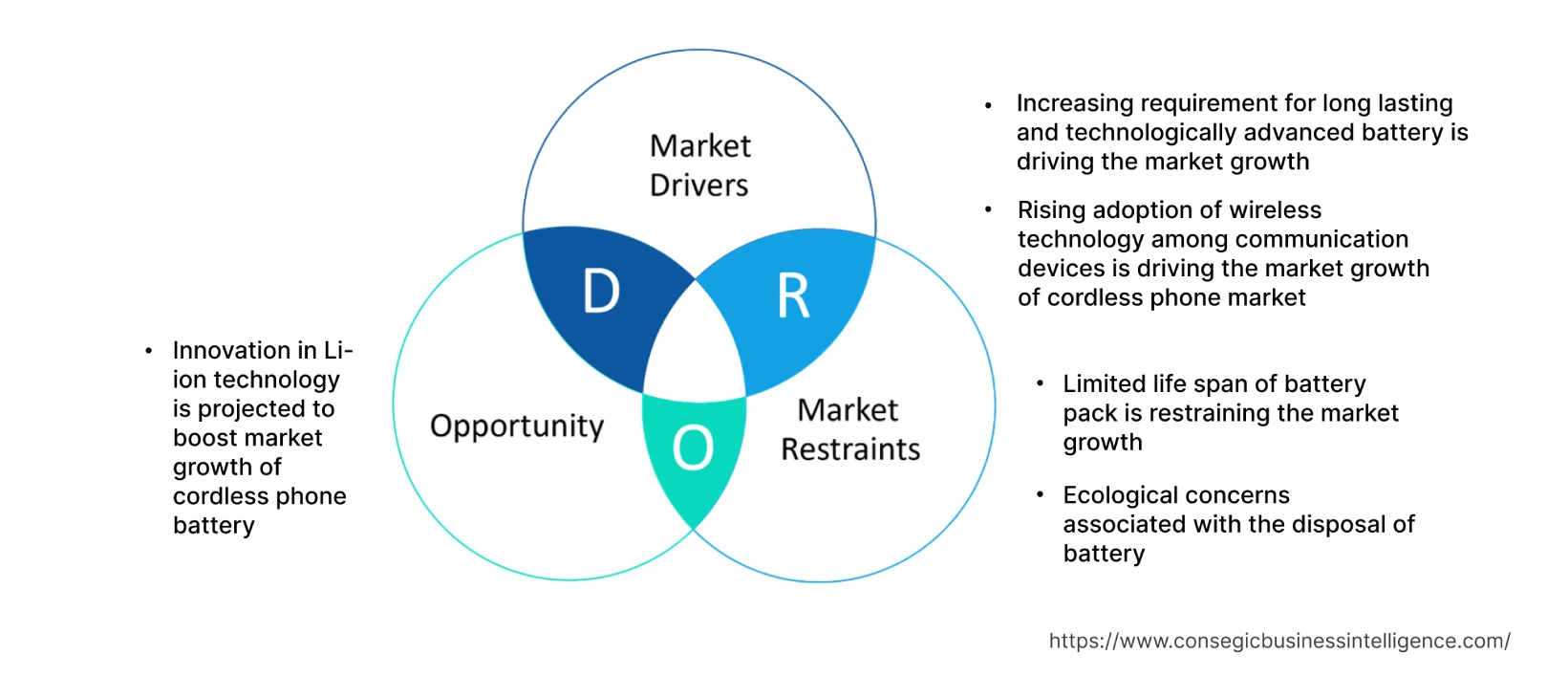- Summary
- Table Of Content
- Methodology
Cordless Phone Battery Market Introduction :
Global Cordless Phone Battery Market Size is estimated to reach over USD 54.14 Billion by 2030 from a value of USD 27.93 Billion in 2022, growing at a CAGR of 8.8% from 2023 to 2030.
Cordless Phone Battery Market Definition & Overview :
Cordless Phone Battery is a electrical energy source that provide power to cordless phone. Aforementioned battery has multiple charge and discharge cycle with extended lifespan of two to three years. These battery packs have the ability to hold charge for a longer duration depending upon the battery capacity, mainly calculated on the basis of capacity. Moreover, it is designed to offer power efficiently for a particular duration depending upon the usage. These phone batteries are an ideal power source as they are rechargeable in nature, portable with small form factor to be carries around and can be designed to function with smartphones of various specifications. They have a predetermined life expectancy as the chemicals in the batteries usually deplete as used for some years.
Furthermore, there are listed battery packs manufactured on the basis of different electrolytic compositions, few of them include NiMH, NiCd, and LI-ion. The key features of above mentioned battery include facility to provide mobility to user is thus driving the market expansion of cordless phone battery.
Cordless Phone Battery Market Insights :
Key Drivers :
Increasing requirement for long lasting and technologically advanced battery.
Cordless phone battery is employed for application including handsfree communication devices including cordless phones. The key factors attributed towards the expansion of cordless phone battery include ease of mobility, wireless connectivity, among others. The ease of mobility during conversation over the phone provides multiple benefits to the consumers including ability to perform multiple tasks, offering of longer duration of talk time, and higher performance factors are promoting the cordless phone battery market demand.
Analysis of market trends concludes that large implementation of energy efficient wireless communications protocols that allows communicating device and base station to communicate efficiently by consuming less power is further driving the market expansion for cordless phone battery market. For instance, DECT (Digital Enhanced Cordless Telecommunications), is a wireless standard implied for landline phones, has been giving a boost to the cordless phone battery market demand.
Rising adoption of wireless technology among communication devices.
Cordless phone is mainly equipped with wireless technology in order to communicate with base station. Cordless phone allows user an ease of mobility and hassle free environment during the talk time. Owing to the aforementioned features, cordless phone is widely in use among the residential and commercial sectors. Improvement in wireless networks including evolutions in the generation of internet from 1G to 5G is proliferating the market. Features being offered by current 4G technology include higher data and voice transfer rate, reduced latency, voice over LTE network VoLTE, and others is promoting the demand for cordless phones which is ultimately driving the need for cordless phones battery.
Analysis of market trends concludes that large implementation of energy efficient wireless communications protocols that allows communicating device and base station to communicate efficiently by consuming less power is further driving the market expansion for cordless phone battery market. For instance, DECT (Digital Enhanced Cordless Telecommunications), is a wireless standard implied for landline phones, has been giving a boost to the cordless phone battery market demand.
Key Restraints :
Limited life span of battery pack.
Cordless phones have limited range to communicate depending upon the wireless connection and battery life. It requires 10 hrs of recharge before it is re-used. Moreover, issues including chemical corrosions caused due to extreme temperatures and moistures content in the environment lead to the reduced battery life. Furthermore, with the continuous utilization of battery reduces the overall battery life to 2-3 years and improper handling further reduces the lifespan to 1-2 years. Thus, owing to aforementioned reasons the life span of a battery in cordless phone is limited causing to be a restraining factor for its market expansion.
Ecological concerns associated with the disposal of battery
Cordless phone battery contains set of batteries to store energy for powering of device. Batteries including Lithium ion, Nickel Metal Hydride, and others function on the basis of chemical reactions which are harmful to the environment. Moreover, improper disposal of aforementioned batteries leads to pilling of harmful chemicals in the landfill resulting in polluting riverbeds, underground water, nearby soil, and others.
Now you've replaced your phone batteries, what should you do with the old ones? It's important not to throw them in the bin. Lithium ion batteries- all batteries, for that matter- contain chemicals which are harmful to the environment. When these go to landfill, those chemicals will eventually leak out into the surrounding soil. Many local councils won't take rubbish bags if they have batteries in them. Thus, in the absence of inefficient measures, there are more likely chances of water pollution, causing severe health complications. Therefore, aforementioned factors tend to limit the expansion of batteries for cordless phone.
Future Opportunities :
Innovation in Li-ion technology.
Li-ion batteries have gained popularity over these years owing to their key features including high power density and longer lifespan. Li-ion batteries are more energy efficient in comparison to lead acid, Nicad, and NiMH thus contributing significantly to its market growth. Moreover, owing to the lower rate of self-discharge compared to Nicad and NiMH is further expected to is emerge as one of many cordless phone battery market opportunities that drive market expansion.
Cordless Phone Battery Market Report Insights :
| Report Attributes | Report Details |
| Study Timeline | 2017-2030 |
| Market Size in 2030 | USD 54.14 Billion |
| CAGR (2023-2030) | 8.8% |
| Based on the Capacity | 300-600mAh, 600-1200mAh, 1200mAh-1800mAH, and more than 1800mAh |
| Based on the Type | Nickel Metal Hydride (NiMH), Nickel Cadmium (NiCad), and Lithium ion (Li-ion) |
| Based on the Application | Residential and Commercial |
| Based on the Region | North America, Europe, Asia-Pacific, Latin America, and Middle East & Africa |
| Key Players | Panasonic Corp., Samsung SDI Co. Ltd., E-One Moli Energy Corp., Ultralife Corp., Shenzhen Highpower Technology Co., Ltd., GS Yuasa Battery Europe Ltd., GP Batteries International Ltd., Duracell Inc., FDK Corp., Artek Energy, and Energizer Holdings Inc. |
Cordless Phone Battery Market Segmental Analysis :
Based on the Capacity :
The capacity segment is segmented into 300-600mAh, 600-1200mAh, 1200mAh-1800mAH, and more than 1800mAh. In 2022, the 600-1200mAh segment accounted for the highest cordless phone battery market share owing to key features including compact form factor and capacity is driving the market dominance of this segment. Moreover, aforementioned capacity of battery is widely available in different type including NiCad, NiMH, and Li-ion.
Furthermore, more than 1800mAh capacity of battery will tend to show the fastest growth during the forecast period owing to the growing requirement of higher capacity of batteries for operating multifunction activities including text and messaging services. Analysis of market trends concludes that function including illuminated keypad consume power that require a high capacity battery for longer operations is thus expected to promote the expansion this segment. For instance, Panasonic offers Ultralink, a NiMH type of battery having capacity of 1800mAh.
Based on the Type :
The type of segment is trifurcated into Nickel Metal Hydride (NiMH), Nickel Cadmium (NiCad), and Lithium ion (Li-ion) Nickel Metal Hydride (NiMH) segment is accounted for holding the largest market share of 43.6% in the year 2022. Evaluation of cordless phone battery market trends showcases that the key factors attributed towards rise in demand for NiMH battery include its high power density up to 25% more than compared to NiCad batteries. Moreover, key advantage for the rise in adoption of NiMH is owing to less vulnerability towards memory effect since consumer don't have to completely drain the battery before recharging it. It is noticed that NiMH batteries possess a 1.5–2 x times higher energy density in comparison to nickel-cadmium (Ni-Cd) batteries. Furthermore, in term of environmental factors NiMH battery is more environmentally friendly compared to traditional NiCad battery as they contain milder toxins and have the ability to be fast charged with designated chargers. However, this battery has high self-discharge rate and requires efficient temperature condition for operation.
Lithium ion (Li-ion) segment is projected to grow at the fastest growth rate during the forecast period. Owing to the factor such as light weight, allows its adoption at the faster rate in comparison to NiCad and NiMH batteries. They are comparatively safer than other batteries as do not possess harmful contents like lead, mercury and flammable electrolytes. The cordless phone battery market analysis concluded that Li-ion batteries have higher power density, which allows them to offer stable performance until discharge. They also do not require periodic discharge for maintenance and have a flat discharge curve, which leads to extended battery performance. Analysis of market trends concludes that factors including lowest self-discharge rate in comparison to other types of batteries is expected to boost the market growth of Li-ion cordless phones batteries.
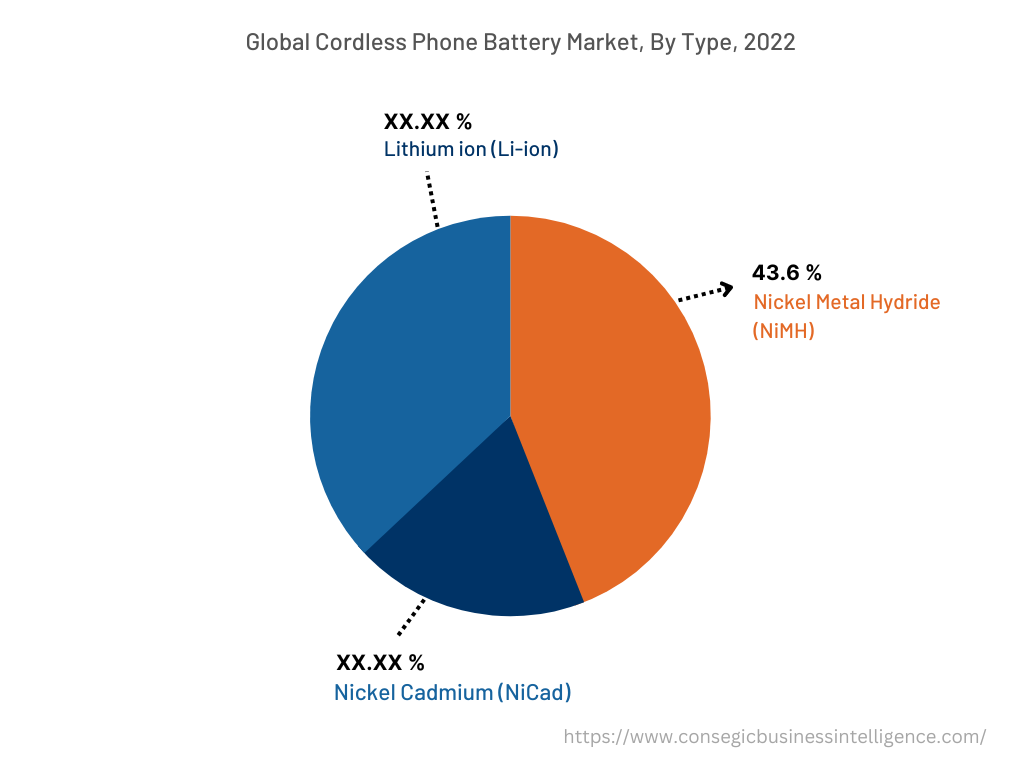
Based on the Application :
The application segment is bifurcated into Residential and Commercial.
The application segment is bifurcated into Residential and Commercial. In 2022, the commercial segment accounted for the highest cordless phone battery market share. The segment is also anticipated to grow at the fastest growth rate during the forecast period, 2023-30. The cordless phone battery market analysis concluded that the key reason for the largest revenue generation of the segment is owing to growing requirements of cordless devices for convenience and mobility. Assessment of market trends suggest that better performance offered by wireless devices in comparison to wired sets tends to drive the cordless phone battery market growth during the forecast period.
Based on the Region :
The regional segment includes North America, Europe, Asia Pacific, Middle East and Africa, and Latin America.
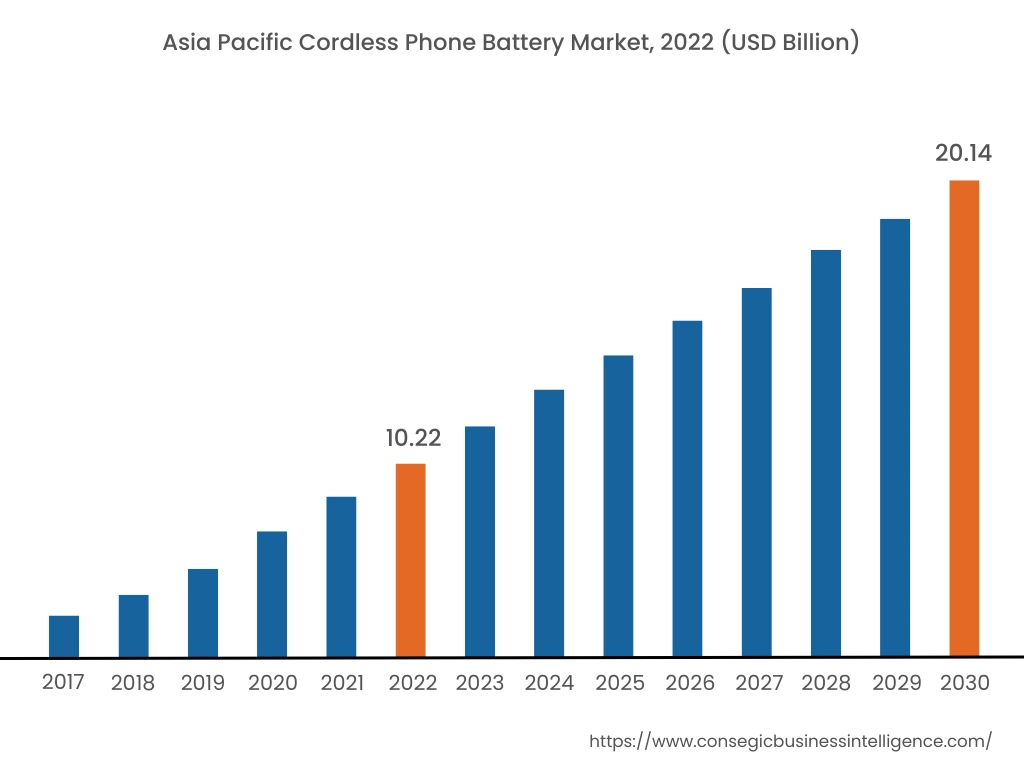
Asia Pacific accounted for the largest revenue share of USD 10.22 Billion in 2022 and is predicted to reach USD 20.14 Billion in 2030 in the cordless phone battery market. Also, Asia-Pacific region is expected to witness fastest growth at a CAGR of 9.1% during the forecast period, 2023-30. In addition, in the region, the China accounted for the maximum revenue share of 31.60% in the year 2022. Analysis of cordless phone battery market trends concludes that China, Japan, and South Korea are contributing significantly to the research and development of battery required for wireless devices. Moreover, owing to the presence of key players including Panasonic Corp., Samsung SDI Co. Ltd., and other China based companies are fueling the expansion of cordless phone battery. In addition, with the growing economy and increasing business activities in the region coupled with rise of commercial space tends to drive the market expansion of Cordless Phone Battery. For instance, Knight Frank India, there was a rise in the demand for office space by 25% in Q1 2022, owing to rise in project completion rate by 13% after the pandemic.
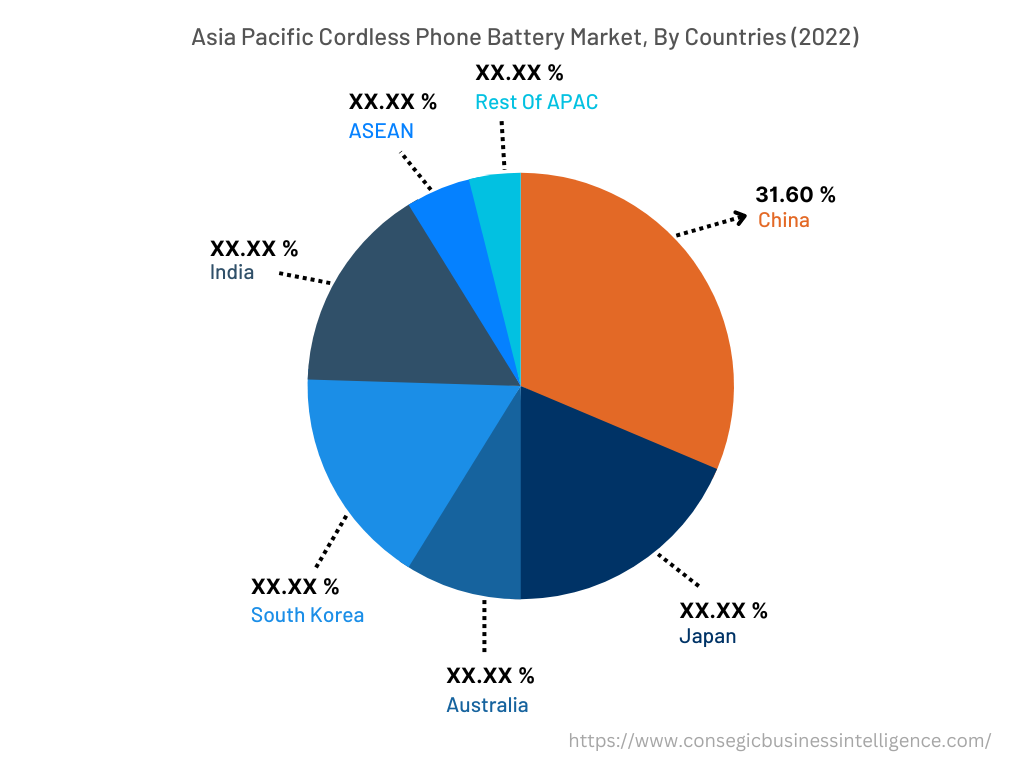
Top Key Players & Market Share Insights :
The landscape of the Global Cordless Phone Battery market is highly competitive and has been examined in the report, along with complete profiles of the key players operating in cordless phone battery industry. Examination of market trends conclude that surge in innovations, acquisitions, mergers, and partnerships in the industry have further accelerated the growth of the Cordless Phone Battery market. Major players in the market include-
- Panasonic Corp.
- Samsung SDI Co. Ltd.
- Ultralife Corp.
- Shenzhen Highpower Technology Co., Ltd.
- GS Yuasa Battery Europe Ltd.
- E-One Moli Energy Corp.
- GP Batteries International Ltd.
- Duracell Inc.
- FDK Corp.
- Artek Energy
- Energizer Holdings Inc.
Recent Industry Developments :
- In July 2023, BCA Industries, Inc. has set up LithiBatt industry facility for the recycling of LI-ion and lithium-iron-phosphate batteries at the large scale.
- In April 2023, Apple has announced its motive to achieve 100 percent recycled cobalt in all Apple-designed batteries being utilised in smartphones and other devices.
Key Questions Answered in the Report
What is a Cordless Phone Battery? +
A cordless phone battery is a battery pack, a source of energy for wireless devices.
What specific segmentation details are covered in the cordless phone battery market report, and how is the dominating segment impacting the market growth? +
The Nickel Metal Hydride (NiMH) segment is accounted to hold largest market share of 43.6% in the year 2022. The key factors attributed towards rise in demand for NiMH battery include its high power density more than compared to NiCad batteries.
What specific segmentation details are covered in the cordless phone battery market report, and how is the fastest segment anticipated to impact the market growth? +
Commercial segment accounted for garnering the largest market share in the year 2022. The segment is also anticipated to grow at the fastest growth rate during the forecast period, 2023-30. The key reason for the largest revenue generation of the segment is owing to growing requirements of cordless devices for convenience and mobility.
Which region is anticipated to witness the highest CAGR during the forecast period, 2023-2030? +
Asia Pacific is anticipated to witness the fastest CAGR during the forecast period due to growing commercial sector and growth of businesses among developing nations.
